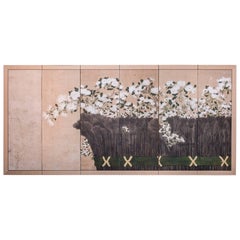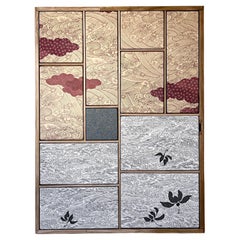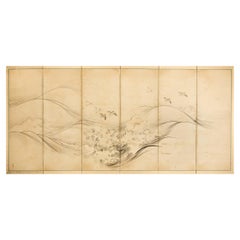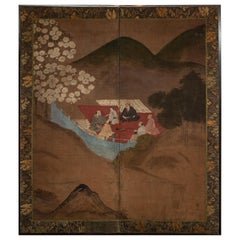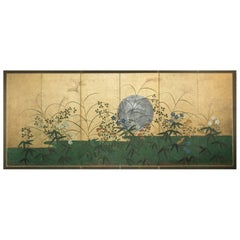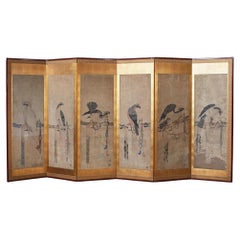Silk Paintings and Screens
to
94
310
106
504
34
1
8
4
2
1
45
213
246
35
115
46
16
11
3
18
7
3
10
8
3
773
759
722
539
492
519
504
425
53
16
539
521
526
30
2
1
1
1
Material: Silk
Japanese Six-Panel Screen, Chrysanthemums and Twig Fence With Gold Flakes
Located in Hudson, NY
Rimpa School painting in mineral pigments with gofun and gold flakes on mulberry paper with a silk brocade border.
Category
19th Century Japanese Antique Silk Paintings and Screens
Materials
Gold
Antique kimono textile art " Waves and clouds ~Eternity~ " by ikasu Beige, Japan
By Kimono ikasu
Located in Setagaya City, JP
This work is inspired by traditional hand-dying technique edo-komon, and is framed in paulownia wood originally used for a kimono chest-of-drawers.
It is elegantly framed with paulo...
Category
1920s Japanese Japonisme Vintage Silk Paintings and Screens
Materials
Silk, Wood
Japanese Six-Panel Screen, Open Ocean
Located in Hudson, NY
Japanese six-panel screen, open ocean, late Edo - early Meiji period, circa 1870, painting of plovers flying over cresting waves. Sumi ink on mulberry paper with a silk brocade borde...
Category
1870s Japanese Antique Silk Paintings and Screens
Materials
Silk, Wood, Paper
Japanese Two Panel Screen, Cherry Blossoms Viewing Party
Located in Hudson, NY
A private viewing in picnic surrounding of nobles (probably samurai), including one woman. Mineral pigments on mulberry paper with silk brocade border.
Category
18th Century Japanese Edo Antique Silk Paintings and Screens
Materials
Silk, Paper
19th Century Japanese Six Panel Screen: Silver Moon Rising Over Summer Field
Located in Hudson, NY
Japanese Six Panel Screen: Silver Moon Rising Over Summer Field. Rimpa Style painting of a moon rising over summer flowers and grasses, including cockscomb and blue bellflowers. Pa...
Category
Late 19th Century Japanese Meiji Antique Silk Paintings and Screens
Materials
Gold Leaf
A Single Late 19th Century Six Panel Paper Screen, in the manner of Soga Chokuan
Located in London, GB
Six gouache painted scenes of tethered hawks, laid down to form a six panel screen, with pigment and ink on rice paper, surrounded by thickly set gold leaf border, and Japanese silk ...
Category
19th Century Japanese Edo Antique Silk Paintings and Screens
Materials
Gold Leaf
20thc Bird Scene Based Meiji Japan 19c Artist Shiki Masaoka The Poet
Located in Amsterdam, Noord Holland
As you can see, Masaoka Nakata's brush, Shiki Masaoka, "Kakikuba", "Autumn leaves", and a bird-and-flower painting / box.
One of the representative haikus of Shiki Masaoka drawn by ...
Category
20th Century Japanese Meiji Silk Paintings and Screens
Materials
Silk
$1,198 Sale Price
20% Off
Japanese Two Panel Screen: Country Farm
Located in Hudson, NY
Unusual subject matter of a rural farm setting with grasses and pine in mineral pigments on paper with silk brocade border and black lacquer trim with bronze hardware. Signature and...
Category
Early 20th Century Japanese Silk Paintings and Screens
Materials
Bronze
Japanese Two Panel Screen, Chinese Literary Figures in Seascape
Located in Hudson, NY
Fine Kano School painting on silk with silk brocade border.
Category
19th Century Antique Silk Paintings and Screens
Materials
Brocade, Silk
Japanese Two Panel Screen Aviary Shaded by A Maple Tree
Located in Hudson, NY
Japanese Two Panel Screen: Aviary Shaded By A Maple Tree, Showa period (1926 - 1989) painting of an outdoor bird enclosure under a maple tree. Painted in ...
Category
Mid-20th Century Japanese Showa Silk Paintings and Screens
Materials
Silk, Wood, Paper
Japanese Six-Panel Screen Buck and Doe at Dawn
Located in Hudson, NY
Japanese six-panel screen: Buck and doe at dawn. Showa period (1926-1989) painting of a rising sun seen through a woodland scene with a pair of deer. In Japan, deer are thought to be...
Category
Early 20th Century Japanese Showa Silk Paintings and Screens
Materials
Bronze
Japanese Contemporary Orange Black Cream Silk Two-Panel Folding Screen, 4
Located in Takarazuka, JP
Extraordinary Japanese contemporary two panel "byobu" or folding screen featuring genryoku style handcrafted silk raised kimono Japanese decorative art in Purple, blue, black and ora...
Category
21st Century and Contemporary Japanese Meiji Silk Paintings and Screens
Materials
Gold
Antique kimono textile art " Plum Blossom Night ~Resilience~ " by ikasu Japan
By Kimono ikasu
Located in Setagaya City, JP
This artwork uses antique fabric from Taisho era (early 1920ies) kimono and paulownia wood taken from antique kiritansu - chest-of-drawers used initially to keep kimonos.
It is eleg...
Category
1920s Japanese Japonisme Vintage Silk Paintings and Screens
Materials
Silver Leaf
Blossom and Tree Scene Meiji Period Scroll Japan 19c Artist Araki Kanpo
Located in Amsterdam, Noord Holland
If it is good enough for the Japanese emperor :)
The painting's inscription says that it was painted in the artist's 82nd year, which would be 1913.
In the early Meiji Period following the Buncho ideal of hasshu kengaku ('learning eight schools'), Kanpo expanded his talents to incorporate Western painting techniques and began studying oil painting with Kawakami Togai (1827-1881) and Kunisawa Shinkuro (1847-1877). He achieved notable recognition as an oil painter and apparently was awarded the honor of painting a portrait of the Empress Dowager. Later Kanpo returned to Nihonga and continued to receive numerous honors for his work. He received a silver medal (2nd place) at the Tokyo Prefecture Crafts Competition in 1887; 2nd place with a painting of peacocks...
Category
Early 20th Century Japanese Meiji Silk Paintings and Screens
Materials
Silk
$5,032 Sale Price
20% Off
Early 20th century (Meiji period) crane scroll. Original storing box
Located in Fukuoka, JP
This Meji -Taisho period painting captures a serene moment in nature, depicting graceful bird resting. Painted on silk . Signed. Includes original storage box
Size: Overall 138/...
Category
Early 20th Century Japanese Meiji Silk Paintings and Screens
Materials
Silk, Paper
Japanese Two-Panel Screen: Bamboo in the Moonlight on Silver
Located in Hudson, NY
Modern painting of the moon through a bamboo grove. Mineral pigments on silver.
Category
Mid-20th Century Japanese Silk Paintings and Screens
Materials
Silk, Wood, Paper
Japanese Six Panel Screen: Courtiers Festival
Located in Hudson, NY
Courtiers are those that are in attendance at a royal court. Beautifuly painted court figures in procession with ancient musical instruments. Tosa School painting in mineral pigments...
Category
Late 18th Century Japanese Antique Silk Paintings and Screens
Materials
Gold Leaf
Japanese Two Panel Screen: Winter into Spring Floral Landscape
Located in Hudson, NY
With nandin, narcissus and chrysanthemums. Signature and seal read: Koun. Mineral pigments on mulberry paper with a silk brocade border.
Category
Early 20th Century Japanese Silk Paintings and Screens
Materials
Brocade, Silk, Paper
Vintage kimono textile art "View from the Window ~Maple&Plum~" by ikasu, Japan
By Kimono ikasu
Located in Setagaya City, JP
This work is a glorious nod to buddhist temples circle windows, with beautiful Japanese garden scape seen outside. Golden leaf on the border of a frame is an expression of light goin...
Category
1930s Japanese Japonisme Vintage Silk Paintings and Screens
Materials
Gold Leaf
Silk, Chinese Painting, 19th Century, Temple Scene, Asia
Located in Saint-Ouen, FR
Silk, Chinese painting, 19th century, temple scene, Asia
Measures: H 81cm, W 48cm, W 1cm.
Category
19th Century Chinese Chinoiserie Antique Silk Paintings and Screens
Materials
Silk
Lovely 20th Century Sen'yo Ogawa Scroll Painting Japan Artist Flowers Painted
Located in Amsterdam, Noord Holland
Sen'yo Ogawa
1882-1971
Japan painter. Kyoto production. Name Tasaburo. After served as apprentice of the Buddhist teacher, I learned a Movie to Chu Asai, exhibited oil paintings to...
Category
Mid-20th Century Japanese Showa Silk Paintings and Screens
Materials
Silk
$1,482 Sale Price
25% Off
Japanese Two-Panel Screen Peony, Wisteria, Cherry and Bamboo on Soft Silver
Located in Hudson, NY
Japanese two-panel screen: Peony, Wisteria, cherry and bamboo on soft silver, Meiji period (1868-1912) painting of a garden in spring. Painted in mineral pigments on oxidized silver ...
Category
Early 1900s Japanese Meiji Antique Silk Paintings and Screens
Materials
Silver Leaf
Japanese Two Panel Screen: Water Fowl by River's Edge
Located in Hudson, NY
Japanese Two Panel Screen: Water Fowl by River's Edge, Showa period (1926 - 1989) painting of fowl on a river bank. Very art deco in style. Painted in min...
Category
Early 20th Century Japanese Showa Silk Paintings and Screens
Materials
Silk, Wood, Paper
Silk Scroll Painting by Matsumura Keibun, 18th Century
By Matsumura Keibun
Located in New York, NY
A silk parchment scroll with a Camellia Flower painting, by Japanese artist Matsumura Keibun (1779-1843).
The younger half-brother to Matsumura Goshun, founder of the Shijo schoo...
Category
1790s Asian Edo Antique Silk Paintings and Screens
Materials
Silk, Parchment Paper
Japanese Six Panel Screen, Peonies and Young Growth on Gold Silk
Located in Hudson, NY
Rimpa floral scene. Pigment on gilded silk, signature and seal read: Hattori Shunyo. Bold colors and strong design elements combined with the trademark tarashikomi (diluted elements created when water is applied to the surface before or after pigments causing them to diffuse) exhibit the artists deep devotion to this important Japanese painting tradition. Notes about artist: Hattori Shunyo (b. 1883) was an artist from Kyoto who graduated the (now) Kyoto Municipal University of Art and fell under the circle of Yamamoto Shunkyo...
Category
Early 20th Century Japanese Silk Paintings and Screens
Materials
Brocade, Silk
Japanese Two Panel Screen: Craggy Landscape on Gold Sil
Located in Hudson, NY
Dramatic Mountain landscape with gnarled pines. Signature reads: Shunsen. Ink painting on gold silk with silk brocade border.
Category
Early 20th Century Japanese Silk Paintings and Screens
Materials
Brocade, Silk
Japanese Two Panel Screen, Turkeys
Located in Hudson, NY
Mineral pigments on silk, mounted on a gold panel, in silk border. Signature and seal read: Yoho.
Category
Early 20th Century Japanese Silk Paintings and Screens
Materials
Silk
Japanese Two Panel Screen: Horse Roundup
Located in Hudson, NY
Interesting and unusual subject matter, Tosa School painting in mineral pigments on gold leaf with silk brocade border.
Category
Late 17th Century Japanese Antique Silk Paintings and Screens
Materials
Gold Leaf
Japanese Six Panel Screen Battle of Yashima from the Heike Monogatari
Located in Hudson, NY
Yamato-e painting depicting a great land and sea battle, the Battle of Yashima, March 22, 1185. The Heike were flushed from the mountainous and prote...
Category
18th Century Japanese Antique Silk Paintings and Screens
Materials
Gold
Actors in Dance / Theatre Scene 20th Century Scroll Painting Japan Artist
Located in Amsterdam, Noord Holland
It is a work of 2 scrolls figure in a Theatre/Dance Noh style.
it is a very tasty work combined with the hymns spelled at the top.
¦ Silk books and handwriting.
¦ State
There ...
Category
Early 20th Century Japanese Taisho Silk Paintings and Screens
Materials
Silk
$2,060 Sale Price
20% Off
K5 Japanese Antiques Hanging scroll, Sun, wave and crane, silk
Located in Niiza, JP
Silk, scroll tip: wood
Size: Image size: 400 (W) x 1240 (H) [mm]
All : 520 (W) x 1870 (H) [mm]
Box size: 80 x 75 x 630 mm, 840g (Not Original box)
Sun, wave and crane, a Japanese ...
Category
19th Century Japanese Antique Silk Paintings and Screens
Materials
Silk
Vintage kimono textile art " Turquoise Forest ~Strength~ " by ikasu Blue, Japan
By Kimono ikasu
Located in Setagaya City, JP
Fabrics featuring iconic Japanese plants like chrysanthemum, maple, and bamboo were gathered from various long underwear and kimono pieces to create a set of canvases (diameter 30, 25 and 20cm) showcasing exquisite gradations.
The top canvas, in pristine white, originates from long under-kimono, while the middle and bottom canvases are skillfully upcycled from kimono fabrics.
<< Period / Story >>
The long under-kimono and kimono fabrics used in these canvases were originally crafted and worn during the late Showa period (1960-80ies).
<< Explanation and meaning of pattern and colors >>
The pattern on the top canvas features a chrysanthemum, an auspicious emblem symbolizing longevity. It is affectionately referred to as the "raccoon dog chrysanthemum" due to the large, overlapping petals resembling the fur of a muzina, a creature similar to a raccoon dog or badger. This motif is highly popular in various plant-inspired designs and frequently seen in Edo komon, katazome, and jimon textiles.
The top canvas naga-juban under-kimono, being entirely white and devoid of any additional dyes, suggests its use as formal wear. Its pristine white hue accentuates the silk's luster when exposed to light and highlights the beauty of the woven patterns.
The fabric used here is rinzu, a type of fabric thinner than crepe de chine, characterized by its soft, smooth texture and subtle sheen. This particular lintel distinguishes itself with the way its ground pattern emerges and also incorporates a woven chrysanthemum pattern.
The central canvas showcases a maple tree, symbolizing longevity, which changes its colors with the seasons, bringing joy and happiness to people's lives.
The bamboo featured on the lower canvas has been regarded as a symbol of good fortune since ancient times, given its straight and vigorous growth, along with the Chinese legend that a phoenix consumes its fruit. It embodies concepts such as "immortality," "longevity," and "strength" because it remains green even in winter. The hollow stem also signifies "innocence," suggesting that there are no hidden agendas.
All three canvases are adorned with ground patterns that, when viewed from a distance, appear as modern works of art, yet upon closer inspection, they reveal a distinct Japanese ambiance.
<< Characteristics of the fabric >>
All three canvases are made of fabrics with jimon. The unique and high level of Japanese weaving...
Category
1970s Japanese Japonisme Vintage Silk Paintings and Screens
Materials
Canvas, Silk
Vintage kimono textile art " Plum Gradation " by ikasu Pink, White, Japan
By Kimono ikasu
Located in Setagaya City, JP
This canvas featuring a plum color gradient kimono showcases a unique decorative variation of the popular seigaiha (青海波) sea waves pattern.
The artwork got a Mr. & Mrs. Abe Arts & Cu...
Category
1980s Japanese Japonisme Vintage Silk Paintings and Screens
Materials
Canvas, Silk
Artists Norikuni Kawamura, Showa Period Scroll Japan 20c Artist Nihonga
Located in Amsterdam, Noord Holland
As you can see, it is a double box and a box with "Shokakuzu" written by Norikuni Kawamura.
The
"Shokaku-zu", which is composed of graceful textures, spreads its wings and flies, i...
Category
20th Century Japanese Showa Silk Paintings and Screens
Materials
Silk
$1,140 Sale Price
20% Off
Japanese Six-Panel Screen "Wild Grasses and Peonies by Rivers Edge"
Located in Hudson, NY
Japanese Six Panel Screen: Wild Grasses and Peonies by Rivers Edge. Early Meiji period (1868 - 1912) painting of a grassy knoll next to a running brook or river. A soft breeze is m...
Category
1880s Japanese Meiji Antique Silk Paintings and Screens
Materials
Gold Leaf
Japanese Two-Panel Screen, Pine, Cherry, and Maple
Located in Hudson, NY
Cherry blossoms and maples among ragged pines. Mineral pigments on mulberry paper with gold mist clouds. Completely remounted utilizing an antique silk brocade...
Category
Mid-19th Century Japanese Antique Silk Paintings and Screens
Materials
Gold, Bronze
Japanese Two Panel Screen: Winter Landscape Under Moonlight
Located in Hudson, NY
A full moon illuminating an ancient gnarled plum tree laden with snow covered blossoms. Mineral pigments on gold leaf with a silk brocade border and black lacquer trim with beautiful...
Category
Mid-19th Century Japanese Antique Silk Paintings and Screens
Materials
Bronze, Gold Leaf
Japanese Two-Panel Screen Ikebana on Gold
Located in Hudson, NY
Japanese two-panel screen: Ikebana on gold. Meiji period (1868-1912) painting of a basket with beautifully arranged spring flowers in the style of ikebana (Japanese traditional flowe...
Category
Late 19th Century Japanese Meiji Antique Silk Paintings and Screens
Materials
Gold Leaf
Japanese Two Panel Screen: Moon and Flowers
Located in Hudson, NY
Showa period (1926 - 1989) painting with a strong design of exotic lilies and a cluster of nadeshiko (dianthus) under a silver moon on gold. This painting has a modern flair, which ...
Category
20th Century Japanese Silk Paintings and Screens
Materials
Silver
VIntage kimono textile art "Geometry ~Chrysanthemums" by ikasu, white, red Japan
By Kimono ikasu
Located in Setagaya City, JP
This work is inspired by traditional Japanese natural symbolism, and is framed in paulownia wood originally used for a kimono chest-of-drawers.
It is elegantly framed with paulownia...
Category
1960s Japanese Japonisme Vintage Silk Paintings and Screens
Materials
Silk, Wood
Japanese Two Panel Screen: Mountain Landscape With Cedar and Pine on Gold Leaf
Located in Hudson, NY
Kano School painting, reminiscent of early Kano School paintings, in sumi (ink) and minimal pigments on gold leaf with a silk brocade border.
Category
Early 19th Century Japanese Antique Silk Paintings and Screens
Materials
Gold Leaf
VIntage kimono textile art " Wish for prosperity " by ikasu Gold, Black, Japan
By Kimono ikasu
Located in Setagaya City, JP
This work is inspired by traditional Japanese nature colors symbolism, and is framed in paulownia wood originally used for a kimono chest-of-drawers.
It is filled with storytelling ...
Category
1960s Japanese Japonisme Vintage Silk Paintings and Screens
Materials
Silk, Wood
K8 Japanese Antiques Hanging scroll, crane, silk
Located in Niiza, JP
Silk Scroll tip: resin
Size Image size: 410 (W) x 1100 (H) [mm] Scroll mounting: 540 (W) x 1900 (H) [mm]
Box size: 80 x 80 x 630 mm 900g Comes with a box, although it is not an orig...
Category
20th Century Japanese Silk Paintings and Screens
Materials
Silk
Vintage kimono textile art "Snowflake ~New Beginnings~" by ikasu Purple, Japan
By Kimono ikasu
Located in Setagaya City, JP
Six canvases (Diameter approx. 30cm, 25cm, 20cm) use the fabric taken from antique kimono, its' various parts, to create one harmonious fluid image of a snowflake - a symbol of new b...
Category
1970s Japanese Japonisme Vintage Silk Paintings and Screens
Materials
Canvas, Silk
VIntage kimono textile art "Geometry ~Marble~" by ikasu Gold, White, Grey, Japan
By Kimono ikasu
Located in Setagaya City, JP
This work is inspired by traditional Japanese nature motifs symbolism, and is framed in paulownia wood originally used for a kimono chest-of-drawers.
It is elegantly framed with pau...
Category
1960s Japanese Japonisme Vintage Silk Paintings and Screens
Materials
Silk, Wood
Japanese Two Panel Screen: Rocky Seascape
Located in Hudson, NY
Mineral pigments on mulberry paper with silk brocade border and black lacquer trim.
Category
20th Century Japanese Silk Paintings and Screens
Materials
Brocade, Silk, Paper
Hawa Beirut Screen by Richard Yasmine
Located in Geneve, CH
Hawa Beirut screen by Richard Yasmine
Materials: Structure in powder coated metal, brushed brass, treated pink marble, stained glass, silk
tassels, Mirror
Dimensions: H 180 x L 20...
Category
2010s Lebanese Modern Silk Paintings and Screens
Materials
Marble, Metal, Brass
$36,902 / item
Japanese Two Panel Screen: Bamboo Grove on Mulberry Paper with Gold Dust
Located in Hudson, NY
Kano School painting of a bamboo grove with blooming flowers and gold dust mists. Painted in mineral pigments on mulberry paper with gold dust and a silk brocade border.
Category
Early 19th Century Japanese Antique Silk Paintings and Screens
Materials
Gold
Pair of Two Panel Japanese Screens: Mountain Landscape with Waterfalls and River
Located in Hudson, NY
Rivers of mist, falling water and moss draped trees evolve into a mystical landscape. Ink on silk, bordered in fine mulberry paper. Sold as a pair.
Category
Late 19th Century Japanese Antique Silk Paintings and Screens
Materials
Silk
Vintage kimono textile art "On Coral Waves ~Everlasting~" by ikasu Pink, Japan
By Kimono ikasu
Located in Setagaya City, JP
<< About this canvas >>
This kimono canvas set of three pieces portrays mountains surrounded by the sea. While each of the three pieces is crafted from different kimonos, they all s...
Category
1970s Japanese Japonisme Vintage Silk Paintings and Screens
Materials
Silk, Canvas
"Literary Gathering" Chinese Scroll Painting, c. 1923
Located in Chicago, IL
Exquisitely painted with delicate line work and a subdued color palette, this Chinese scroll painting is an Late 20th-century reproduction of a...
Category
Late 20th Century Chinese Silk Paintings and Screens
Materials
Silk, Paper
Framed Japanese Portrait of a Buddhist Priest by Goro Kamenaga
Located in Atlanta, GA
A gouache on silk painting of a Buddhist priest by Japanese painter Goro Kamenaga (1890-1955). The highly realistic painting depicts a figure in seate...
Category
1910s Japanese Meiji Vintage Silk Paintings and Screens
Materials
Silk
Japanese Six Panel Screen: Karako 'Chinese Children'
Located in Hudson, NY
Children at play in a Chinese palace garden, a favorite subject of Japanese painters. Kano School painting in mineral pigments on mulberry paper with si...
Category
18th Century Japanese Antique Silk Paintings and Screens
Materials
Bronze
Meiji Period Japanese Four Panel Screen Bijin At Leisure
Located in Hudson, NY
Japanese four panel screen: Bijin At Leisure. Ladies in a tea house with a small dog. Seal reads "Ensan dai" (drawn by Ensan). Meiji Period (1868 - 1912) pa...
Category
Late 19th Century Japanese Meiji Antique Silk Paintings and Screens
Materials
Silk, Wood
Vintage obi textile art " Moon phase II " by ikasu Silver, Black, Japan
By Kimono ikasu
Located in Setagaya City, JP
<< About this artwork >>
This artwork has been upcycled from a stunning obi, which is adorned with calligraphy weaving saying "moon" and "moonlight".
<< Period / Story >>
The obi...
Category
1970s Japanese Japonisme Vintage Silk Paintings and Screens
Materials
Silver Leaf
Antique kimono textile art " Kobachi ~ Coral Collection ~ " by ikasu Pink, Japan
By Kimono ikasu
Located in Setagaya City, JP
This work is inspired by the coral color palette, and is framed in paulownia wood originally used for a kimono chest-of-drawers.
In this artwork, the aim was to capture the wide pal...
Category
1920s Japanese Japonisme Vintage Silk Paintings and Screens
Materials
Silk, Wood
Japanese Two Panel Screen: Ikebana 'Flower Arrangement'
Located in Hudson, NY
Mineral pigment on gold silk. Signature reads: Nana Keicho Ho, Shinsho, Gachu ; Seal reads: Soju ; Seal on reverse reads: Koto Fusai.
Category
Late 19th Century Japanese Antique Silk Paintings and Screens
Materials
Silk
Japanese Two Panel Screen Moon Viewing
Located in Hudson, NY
Japanese two panel screen: Moon Viewing, painting of two noblewomen admiring the full moon outdoors. Extremely sophisticated execution of painting ove...
Category
1970s Japanese Showa Vintage Silk Paintings and Screens
Materials
Silk, Wood, Paper
Japanese Two Panel Screen Suiboku Landscape in Sesshu Style
Located in Hudson, NY
Suiboku is a style of ink painting that is reminicent of the way calligraphers paint. Masterfully painted Muromachi Period (1336-1573) painting, unique in style and strength for the period with very bold lines. Sesshu Toyo...
Category
16th Century Japanese Antique Silk Paintings and Screens
Materials
Silk, Paper
Vintage kimono textile art "Flowers ~Life Circle~" by ikasu Pink, Black, Japan
By Kimono ikasu
Located in Setagaya City, JP
<< About this canvas >>
This canvas is crafted from three different haori fabrics, each adorned with a shibori dyeing flower motif going through entire fabric. These fabrics tell a ...
Category
1970s Japanese Japonisme Vintage Silk Paintings and Screens
Materials
Canvas, Silk
Recently Viewed
View AllMore Ways To Browse
Japanese Red Lacquer Frame
Lattice Panel Wood
Hanging Japanese Screen
Japanese Lattice
Japanese 19th Century Meiji Period Silk Painting
Japanese Buddhist Screen
Japanese Carved Screen
Japanese Screens And Doors
Monkey Screen
Japanese Autumn Screen
Japanese Screens Six Fold
Japanese Wood Room Divider
Kyoto Silk Painting
Japanese Dragon Painting
Japanese Birds Painted On Silk
Heian Period
Japanese Crane Panel
Japanese Divider Screen
